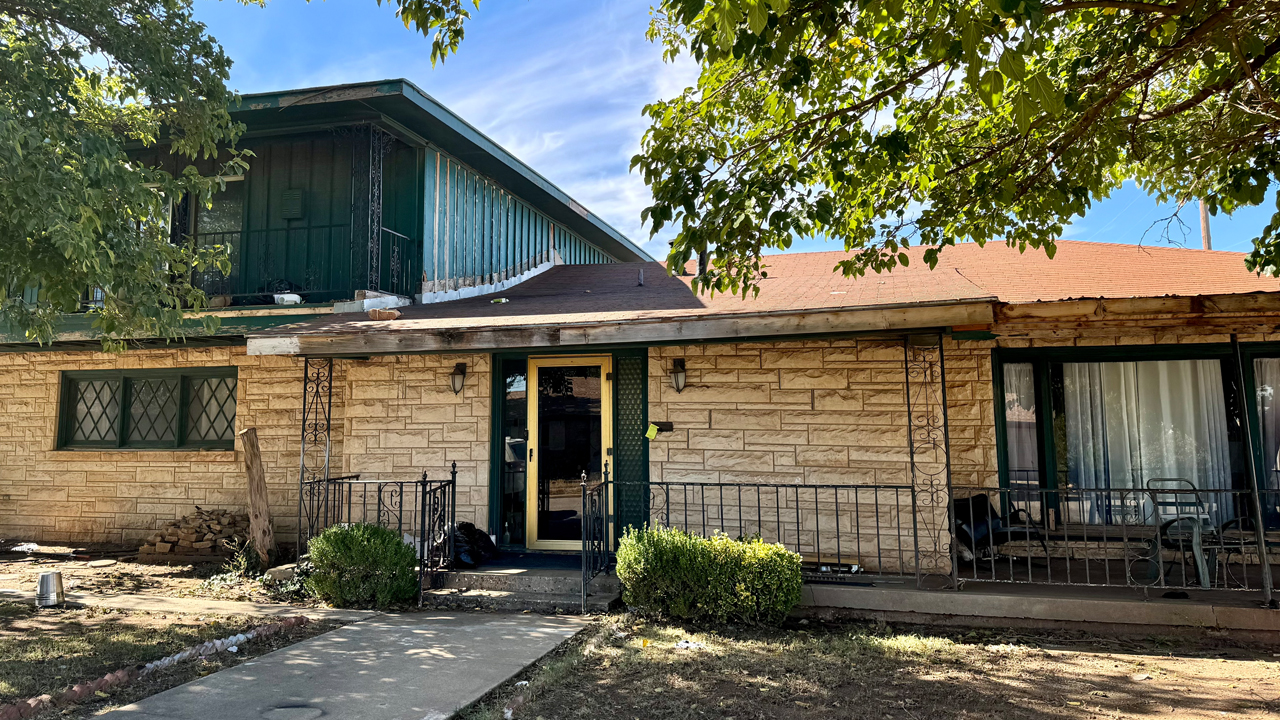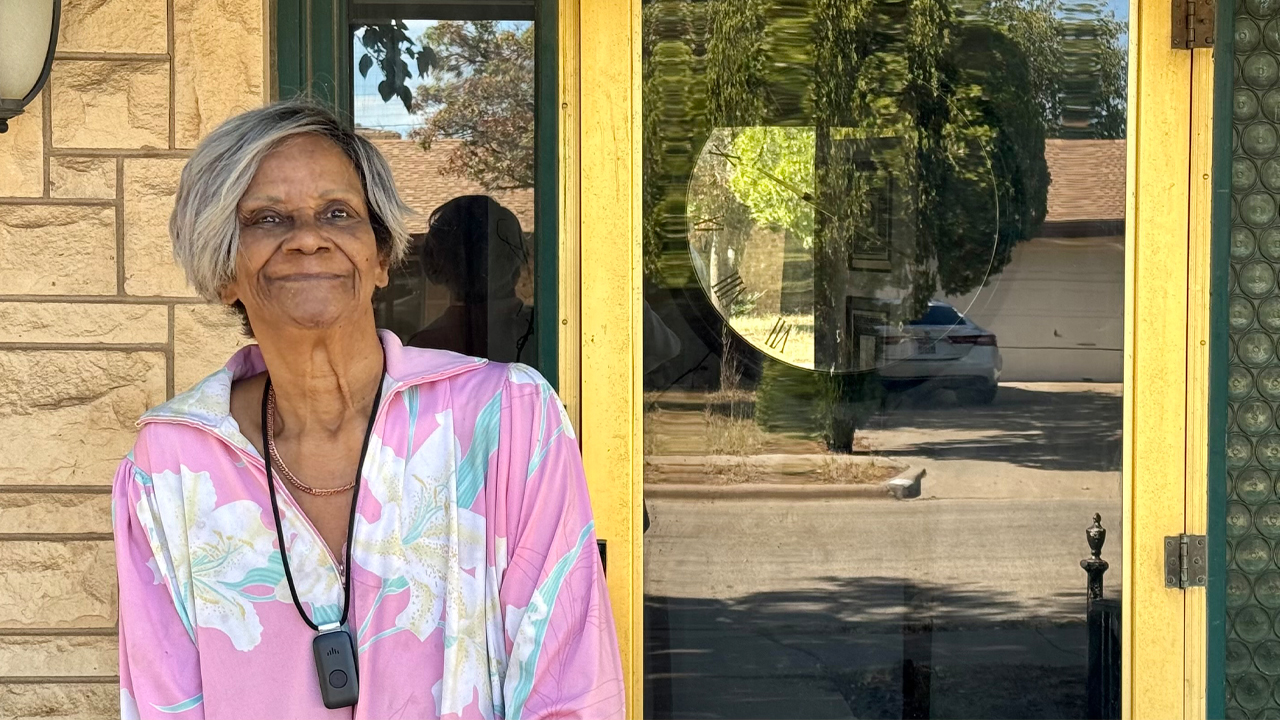Judith Struggs in front of the home she wishes to get designated as a historic place
E.C. Struggs made an impact in Lubbock as an educator – mostly when Lubbock schools were segregated.
Samuel Ayers never met Struggs but was inspired by him, and Ayers now inspires others.
Struggs also made an impact on his daughter Judith, who’s hoping the city will approve a historic marker placed on the family’s East Lubbock home where she still lives at 2002 Cedar Ave., but that’s hit a roadblock she hopes is temporary.
She recalled a time before integration when her dad came home, sat on the side of the bed and wept. He’d been to the Central Office and asked administrators for uniforms and instruments for his students and was turned down.
“My parents literally shed blood, sweat and tears to build this home,” Judith said.
Ashley Padilla, a planner for the city of Lubbock, thinks it would be great recognition of someone who did a lot for the community and schools.
“It’s another step in preserving our history. We don’t have very many local historical landmarks around the city, so when there are eligible ones, they should be preserved,” said Padilla.
Ayers, who wrote a book about E.C. Struggs, said: “When people think of education and school, they think of E.C. Struggs; he was a leader in the community and a leader in East Lubbock,” said Ayers.
Born: October 3, 1900
Died: August 18, 1979
Where: Wallis, west of Houston
• 1925: Bachelor of arts degree from Paul Quinn College.
• 1929: Bachelor of science in education from Prairie View Normal and Industrial College, now Prairie View A&M University.
• 1948: Master of Arts degree in Administration and Supervision from the University of Michigan.
• 1925: Teacher and principal at what was then called Minerva Colored School northeast of Austin.
• 1930: Principal, teacher and coach of Dunbar High School in Lubbock.
• 1930: Married Lillian Carolyn Porter.
• 1935: Lillian earned a master’s degree in education.
• 1952: Adopted daughter Judith.
• Carver Heights Nursery.
• Southeast Lubbock Developments Board.
• Lubbock County Improvement Board.
• Mayor’s Committee for Observance of United Nations Week.
• Omega Psi Phi Fraternity.
• World War II Draft Board.
• President of the West Texas District Teachers Association.
• Texas Principals Association.
• National Education Association.
Requesting historic marker
Judith withdrew the request for a historic preservation zone (which comes with a historic marker) when the issue came before the Lubbock City Council on September 29.
Kristen Sager, director of planning, said, “She indicated that she would apply again and start the process over, but she has not submitted a new application at this time. So currently, we are just waiting for her to reapply.”
The city’s planning and zoning committee recommended denial of a historic designation in early September. Committee members raised questions about how the house would educate the public about E.C. Struggs.
LubbockLights.com dug a little deeper and found public access to the home and education efforts are not a requirement.
The committee also had concerns the home is not in top shape. The designation as “historic” makes the home eligible for a city property tax break to offset rehabilitation costs for up to five years.
Judith told LubbockLights.com she’s working with someone to help her reorganize the request for a historic designation, adding her motivation is to honor her father.
Sager said Lubbock has 44 properties with a local historic designation. Examples would be the “Wiley/Smith/Quilliam Home” (owned at one time by Governor Preston Smith) and the “Kreuger-Scott Home” (built for the co-founder of Methodist Hospital) – both along 19th Street across from Texas Tech.
Coming to Lubbock almost a century ago
Struggs started teaching in his native East Texas in a two-room schoolhouse.
He heard about an opportunity in Lubbock but hesitated about moving so far west.

However, during his interview with Lubbock Superintendent M.H. Duncan, he observed the treatment of black residents in West Texas was noticeably better than in the East. He accepted an offer to teach math and science to upper-level students at segregated Dunbar High School, according to Ayers’ book, “E.C. Struggs, Dunbar’s Visionary Leader.”
As the school’s student body grew, so did interest in basketball and football. Despite having no athletic background, Struggs stepped in as coach for both teams. Dunbar didn’t have funding for a football program. Struggs approached other local principals and got used equipment, the book said.
This temporary fix worked until Struggs met with Texas Tech football coach Pete Cawthon, who donated Texas Tech’s old gear and supplies. In return, proceeds from Dunbar’s games went toward purchasing a new sports clock for Texas Tech, the book said.
Struggs was a prominent figure in education in East Lubbock and deeply involved as a member of Bethel Church. He played a key role in the planning and construction of the church when it relocated. Additionally, he donated the stained-glass window depicting Jesus Christ, which was dedicated in honor of his father, E.W. Struggs, Ayers’ book said.
E.C. Struggs Junior High was named in his honor before it closed in 1979.
Adopting a daughter
When Struggs and his wife temporarily relocated to Michigan during summers to work on his master’s degree, they stayed with a couple who were raising their granddaughter. Over those summers, they fell in love with the girl and adopted Judith.
From a young age, Struggs told Judith anything she aspired to do she would be able to do.
“I loved him because he gave me every opportunity that one could give a child. I literally grew up with a silver spoon in my mouth. I don’t have a rags-to-riches story to tell. Mine was all riches,” says Judith.
She grew up a “daddy’s girl,” she said.
“My dad was one who kept me smiling, he was a kind and generous man and did all the spoiling,” she said, adding he was hilarious, always cracking jokes and making her laugh.
“I can remember him saying, I’m not going to get on a plane because if the plane stops flying, I don’t have wings, and I can’t fly,” she said.
Her parents’ values greatly influenced Judith; she was actively involved in school and church throughout her upbringing.
When choosing where she wanted to go to college, she said her parents told her she could choose anywhere in the United States. She chose Howard University for music education but ended up coming back home and finishing at Texas Tech.
Judith went on to get her master’s degree in education from Texas Tech University. She went on to teach.
Struggs cared about his students as well, she said.
Judith says there was one time the school was going on a trip; one student didn’t have her uniform. Struggs took her shopping and got her everything she needed for that trip.
“He backed up his students all the way,” said Judith.

An inspiration to Ayers
Samuel J. Ayers is originally from San Antonio. He was the former principal of Estacado High School and now works at Lubbock Christian University, where he teaches future teachers and administrators. He coordinates the principalship program and is the executive director of graduate Education.
Ayers graduated from Trinity University in 1984 and spent a few years teaching at Alamo ISD. After completing his master’s degree, he and his wife, originally from Lubbock, decided it was time for the next step and moved back to Lubbock in 1986. With his sights set on earning a doctorate, Ayers enrolled at Texas Tech University.
Ayers taught at Iles Elementary School, a magnet school in East Lubbock that was once the original Dunbar School. While there, he taught language arts, social studies and history before advancing to the principal role.
While teaching at Iles Elementary, Ayers explains he came across a picture of Struggs hanging on the wall. His passion for history sparked a curiosity to learn more about Struggs, which led him to write a biography about the educator. Since then, Ayers has written around 16 biographies, most focusing on influential figures from the Lubbock area. He says his motivation is to shed light on individuals from the community who made a positive impact and invested in Lubbock’s growth.
“I wanted to be an elementary teacher because I wanted to catch kids when they were most impressionable and if I could get them to love learning in elementary school, hopefully, I would carry them through, even if they, like me, only had a few outstanding teachers after that,” said Ayers.
In sixth grade, a pivotal moment came when his teacher, Miss Thompson, made learning enjoyable and engaging. She left such an impression on him he aspired to inspire others as she had. Throughout his teenage years, Ayers explained he volunteered at summer camps for the Boy Scouts and YMCA, teaching various skills. He shared his knowledge of astronomy, identified trees and taught kids how to row and swim. Through these experiences, he discovered a natural talent for teaching and by the age of 16, he was sure he wanted to become a teacher.
Ayers admires Struggs’ presence; he always showed up. Struggs was fully engaged, whether it was sports games, luncheons, or school events. He made it a point to know his students by name and their families.
“Even though he wasn’t athletic himself and hadn’t really playedsports that I could find anywhere, he was the first coach for those boys who wanted to play ball. And I thought, okay, that’s really being dedicated to your students and learning something about what they want to do in extracurricular activities to make that school experience better for them,” said Ayers.
This commitment left a lasting impression on Ayers. When he became principal, Struggs’ influence inspired him to adopt the same approach, fostering genuine connections with his students and attending their events to show his support.
“I really wanted those students to know that their principal saw them and they mattered to me,” said Ayers.
Comment, react or share on our Facebook post.

